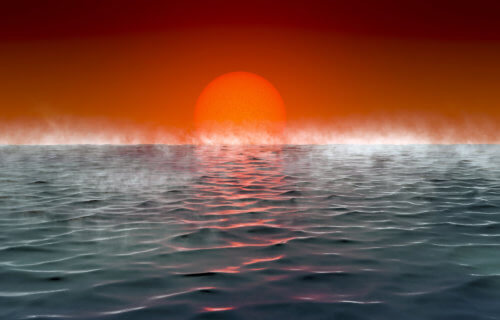CAMBRIDGE, England — Life could exist on a vast number of “waterworlds” very different from Earth, according to new research. A new class of potentially habitable worlds called “Hycean planets” has been identified, taking the search for extraterrestrials a giant step forward. Astronomers are hopeful signs of alien organisms outside our solar system will be found in the next couple of years.
Hycean planets are hot, with hydrogen-rich atmospheres, and covered by deep oceans. They are more numerous and observable than Earth-like planets, researchers say. Picking up “biosignatures” within the next two or three years is a real possibility.
“Hycean planets open a whole new avenue in our search for life elsewhere,” says lead study author Dr. Nikku Madhusudhan of Cambridge University’s Institute of Astronomy, in a statement. The findings massively improve the chances life has evolved elsewhere in the universe and is perhaps widespread.
The study suggests the Hycean planets are more capable of sustaining life than those of similar size, mass, temperature, and atmosphere to Earth. Many of the prime candidates are bigger and warmer than Earth, but still have the characteristics to host vast seas. They could support microbes similar to those in some of Earth’s most extreme aquatic environments.
The planets also allow for a far wider “Goldilocks zone,” where it’s neither too hot nor cold. They could still support life even though they lie outside the range where a planet similar to Earth would need to be in order to be habitable. Researchers identified several potential Hycean worlds that could be analyzed by the James Webb Space Telescope (JWST). It’s due to be launched later this year. The planets all orbit small red dwarf stars 35 to 150 light-years away — close by astronomical standards.
Which Hycean planets are most likely to have life?
The most promising planet is known as “K2-18b,” which lies about 110 light-years away. Observations are already being planned and could lead to the detection of one or more molecules that are signs of life. These molecules include oxygen, ozone, methane, and nitrous oxide, which are all present on Earth.
“A biosignature detection would transform our understanding of life in the universe. We need to be open about where we expect to find life and what form that life could take — as nature continues to surprise us in often unimaginable ways,” says Dr. Madhusudhan.
There are also a number of other biomarkers, such as methyl chloride and dimethyl sulfide, that are less abundant on Earth. But they can be promising indicators of life on planets with hydrogen-rich atmospheres, where oxygen or ozone may not be as abundant. “Essentially, when we’ve been looking for these various molecular signatures, we have been focusing on planets similar to Earth, which is a reasonable place to start. But we think Hycean planets offer a better chance of finding several trace biosignatures,” Dr. Madhusudhan adds.
More than 4,000 exoplanets outside the solar system have been discovered. The vast majority are between the sizes of Earth and Neptune and are often referred to as super-Earths or mini-Neptunes. They can be predominantly rocky or icy.
The pressure and temperature beneath the hydrogen-rich atmospheres had been thought too high to support life. But Dr. Madhusudhan and colleagues found in certain conditions this would not be the case. Hycean planets can be up to 2.6 times larger than Earth and have atmospheric temperatures up to nearly 200 degrees Celsius (392F). But their massive worldwide oceans could be similar to those conducive for microbial life in Earth’s seas.
Such planets also include tidally locked dark and cold Hycean worlds that may have habitable conditions on their permanent night sides or receive little radiation from their stars. They are also likely to be common, meaning the most promising places to look for life elsewhere in the galaxy have been hiding in plain sight. “It’s exciting that habitable conditions could exist on planets so different from Earth,” study co-author Anjali Piette, a Ph.D. student at Cambridge’s Institute of Astronomy, said.
A number of trace terrestrial biomarkers expected to be present in Hycean atmospheres would be readily detectable. The larger sizes, higher temperatures, and hydrogen-rich atmospheres of Hycean planets make them much easier to spot.
The study is published in The Astrophysical Journal.
South West News Service writer Mark Waghorn contributed to this report.
